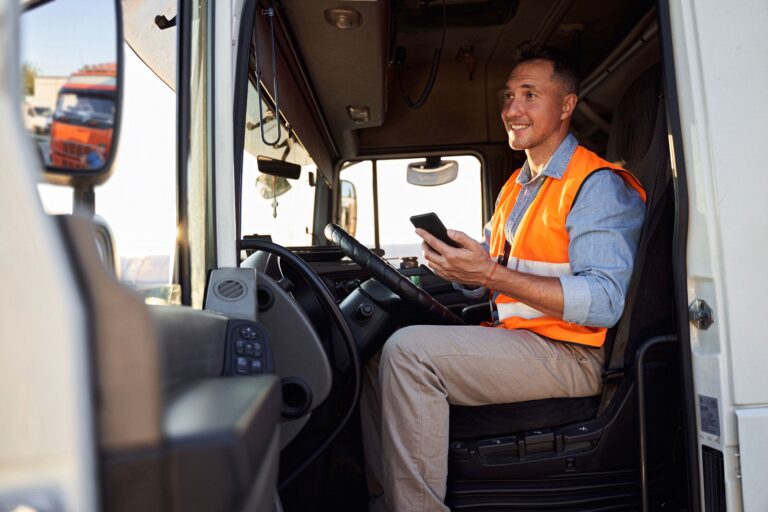For many of the estimated 3.5 million truck drivers in the U.S., mobile apps have become essential tools for their work on the road. These apps allow drivers to handle tasks like scanning and submitting paperwork, communicating with dispatchers, logging hours, and finding nearby truck stops or weigh stations – all from their mobile devices.
Trucking apps replace manual processes and put key information at driver’s fingertips. As such, they significantly boost efficiency and convenience for this vital workforce – after all, truckers move 65% of all U.S. freight, according to the Department of Transportation.
However, for these apps to truly benefit a driver, they must deliver three things: The features truckers need the most, a user-friendly experience, and reliability.
To understand how well current trucking apps are meeting drivers’ needs, we analyzed real user feedback and identified areas where developers and trucking companies still need to improve.
Methodology
We examined 53 publicly accessible mobile apps from the top 100 U.S. trucking companies as ranked by the American Journal of Transportation (AJOT) in 2024. This sample includes a mix of truckload (TL), less-than-truckload (LTL), third-party logistics (3PL), intermodal, and other operating models.
We then analyzed reviews for these apps on the Play Store and App Store from 2023 onward to identify common points of praise, complaints, and improvements requested by the drivers themselves. With these insights, we can get a clear picture of the current state of trucking apps and what drivers truly want from their mobile tools.
The state of trucking apps
Overall, user sentiment is mixed – the average app rating is 3.5/5 on the Play Store and 4.0/5 on the App Store as of April 17, 2024. While a few apps have earned rave reviews for making drivers more productive and effective, many others were panned for poor performance or disregarding user needs.
What drivers like most
At their best, trucking apps are virtual co-pilots that pack essential tools and information into one handy mobile solution. The highest-rated apps earned praise for features like:
- Integrated truck-specific navigation: Get accurate directions, routes, and traffic data optimized for commercial truck dimensions and weights.
- Messaging and document uploads: Quickly scan and submit paperwork like bills of lading right from the app. Easily communicate with dispatchers, brokers, or customers.
- Finding amenities: Locate nearby truck stops, weigh stations, truck-approved parking, restaurants, and other services along the driver’s route.
The top-rated apps didn’t just check the boxes on key capabilities, however. They also deliver these features through intuitive, easy-to-use interfaces. This way, they actually simplify tasks rather than creating more headaches. Reliability was also crucial: Seamless functionality and minimal crashes or bugs allow drivers to stay focused on the road and on the job at hand.
One driver praised their app thus: “So far, it’s been perfect and very convenient. I’m getting information immediately. I don’t have to stand by in the truck waiting for my info. I can receive and send information instantly. (…) I love the freedom this app gives me to communicate with my company anywhere I am.”
Best-in-class driver apps
Out of the apps we investigated, two stood out for receiving exceptionally positive feedback from drivers: Prime Mobile and LandstarOne.
The main reasons:
- Efficiency and ease of use: Users found these apps made their jobs easier and saved them significant amounts of time. Features like truck-optimized navigation, intuitive document submission, and fast access to key information were mentioned as particularly useful.
- Comprehensive functionality: These apps consolidate the essential tools drivers need into a single tool. Having a true “one-stop shop” for daily core workflows and operations on the road is a major advantage.
- Reliability and user-friendly design: Reviewers praised the simple layouts, reliable performance, and user-friendly interfaces of these standout apps. They help drivers manage their activities and duties effectively while staying out of their way, preventing frustration while driving.
Importantly, what makes these apps best-in-class isn’t necessarily including the richest feature set – but making the features drivers actually use every day as seamless as possible.
What needs improvement
Still, user complaints revealed that many trucking apps have significant room for improvement, falling far short of a seamless “virtual co-pilot” experience. There were four particular areas of criticism:
- Reliability and performance issues: Poor connectivity and app performance prevent drivers from reliably accessing key features and data. Reviewers are particularly frustrated with regular crashes, freezes, slow loading times, failure to sync with other software, failure to load information like routes or documents, and problems with certain phone models.
- Document scanning: An app’s document scanning and upload functionality is often a major sticking point, with users complaining about blurry scans, crashes during scanning, and the inability to capture paperwork like bills of lading accurately. One driver lamented: “Absolutely infuriating, this thing will take a perfectly clear image, then blur it after you hit the button to take a picture of a BOL.”
- Inaccurate location tracking and trip planning: Many drivers expressed concerns about inaccurate GPS routing and location tracking. Reviews mentioned inaccurately tracked activities, being tracked even while off-duty (raising privacy concerns), and difficulties finding truck-approved amenities, routes, and parking along their route. For an app experience supposedly optimized for a mobile workforce, a lack of intelligent location and mapping capabilities is a serious failing.
- Dated user interfaces and app design: Outdated UI/UX design made some apps feel “clunky” and difficult to navigate. Specific pain points included small input fields, lack of skip and undo options, frequently used actions buried under layers of menus, and unintuitive workflows that did not suit how truck drivers worked.
Issues are not limited to the ones mentioned: Problems like unreliable messaging capabilities, a lack of seamless HOS log integration, and log-in or password-reset problems are less common but no less frustrating for drivers.
The way forward: building better trucking apps
The app reviews show one thing clearly: By delivering reliable, driver-focused app experiences, trucking companies can boost productivity, safety, and job satisfaction for their mobile workforce and differentiate themselves from competitors.
Based on the user feedback we’ve analyzed, there are four key areas for developers and trucking companies to invest in:
- Enhancing performance and offline functionality: Poor connectivity is an everyday occurrence for drivers. Yet many current apps depend on a good internet connection, and slow to a crawl or even crash without one. This loss of function renders them ineffective as work tools. Investing in performance optimizations, smarter data handling, and reliable offline modes could allow vital capabilities like document scanning to work anytime, anywhere.
- Improved document scanning: Industry-leading solutions like Scanbot SDK’s offline mobile document capture software provide highly accurate scanning and data extraction, even from poor-quality images captured in challenging conditions like low light.
- Sophisticated location capabilities: App developers can integrate truck-specific mapping data, routing intelligence, and location services optimized for commercial vehicles. This enables more accurate tracking and navigation, robust trip planning capabilities, and tools to easily find truck stops, weigh stations, and road services based on the driver’s real-time location.
- User-centric design and workflows: When it comes to outdated UIs, a new coat of paint is rarely enough. By observing how drivers actually work and by collaborating with UX experts, developers can rebuild workflows, interfaces, and capabilities around drivers’ needs – not tack on cumbersome processes. In particular, a focus on accessibility, one-handed use, voice input, and glanceable information can improve usability while driving.
Ultimately, to retain talent and attract younger drivers with higher tech expectations, trucking companies must embrace a “mobile workforce first” mindset with their apps.

Want to learn more about document scanning?
Here’s what you can do next:
- Read our brochure about how a Document Scanner SDK can help your company save time and money.
- Try the demo app to get a glimpse of the SDK’s functionalities.
- Get in touch with our Sales team to discuss your use case with our solution experts.







